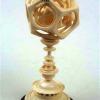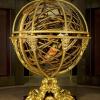Armillary Sphere
Armillary sphere; brass; 995 mm high; Italy (?), c. 1580. Museum of the History of Science, University of Oxford, Inventory No. 70229.
Description. This large and impressive brass armillary sphere is both a working astronomical instrument and a decorative object of display, with a finely modelled sculptural base. It is constructed according to the ancient geocentric view of the Universe, as codified by Ptolemy in the second century CE. Surrounding the Earth are the great circles of the heavens, with the Sun in the broad ecliptic band of Zodiac signs. On the ecliptic, the vernal equinox is dated 10 March, indicating that the sphere was constructed before the introduction of the Gregorian calendar within the Catholic world in 1582. Hence the presumed date: no date or maker’s mark are present. Once set up for the user’s latitude, it can solve problems of spherical astronomy, such as the time of sunrise on any day of the year. The sphere is supported by a stand consisting of three rampant lions. The stand is engraved with the four cardinal points, which were originally orientated by means of a compass, which is now missing.
Provenance. The instrument is unsigned and of uncertain origin, but is thought to have been made in mainland Europe. However, the base is engraved with the coat of arms and quarterings, crest and badge of Henry Percy, 9th Earl of Northumberland, K.G. (1564-1632), generally known as 'The Wizard Earl' on account of his interests in astronomy, astrology, alchemy and other branches of natural philosophy. He employed leading English mathematicians such as Thomas Harriot, Walter Warner, and Thomas Hughes during his 16-year imprisonment in the Tower of London on suspicion of involvement in the Gunpowder Plot. The insignia include the Garter, which he received in 1593.
Before this personal disaster, the sphere had already passed to Captain (later Sir) Josias Bodley 1550–1618), the younger brother of Sir Thomas Bodley (1545–1613), who founded Oxford’s Bodleian Library. In 1601 Sir Josias presented the sphere to Bodley’s library, along with a gilt bronze quadrant of 1579 by the celebrated Augsburg instrument-maker, Christoph Schissler. But the armillary sphere was kept at Sir Thomas’s London house until his death in 1613. It has been in Oxford ever since, firstly on display in the Bodleian, then lent to the University Observatory in the late 1800s, and finally coming to the History of Science Museum in the 1951.
Further resources
Brief animation explaining the structure and function of an armillary sphere, from the Museum of the History of Science.
Brief video explaining the features and function of MHS inventory number 45453.
Discussion of the armillary sphere by Adam Mosley (1999) on the Starry Messenger website, HPS Cambridge.
Beautiful examples of Atlases, armillary spheres and globes at the Museo Galileo in Florence.
Credits. The text is derived largely from the description of this object amongst the highlights of the HSM and the overview on Epact, which also provides further technical detail; see also Rogers, Bodleian Library, no. 28.


